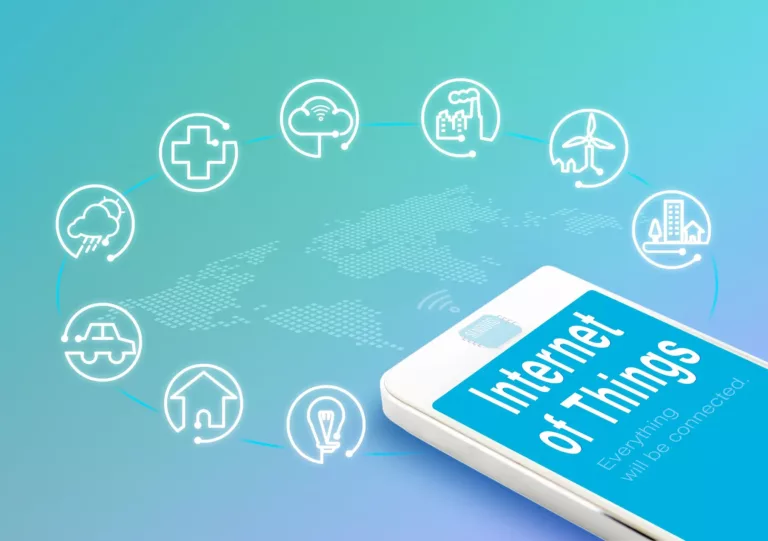IoT APIs are essential for unlocking the full power of development. The Internet of Things (IoT) is a business of massive proportions. IoT is the ecosystem of billions of devices connected through the internet at the barebones, and each device is collecting and sharing information. These devices aren’t limited to smartphones and computers—they can be as tiny as a pill-sized camera or as huge as a jet.
Carrying chips, sensors, and API (application programming interfaces), these devices reach a level of intelligence that powers the real-time sharing of information. IoT is like a massive web that merges the physical and digital worlds, allowing end-users to make quicker and smarter decisions—many can even be life-saving.
IoT Yesterday, Today, and Tomorrow
The idea of incorporating sensors and intelligence into otherwise ‘dumb’ objects started in the 1980s and 1990s. An internet-connected vending machine was one of the earliest projects, but it didn’t pan out because the technology to make it wasn’t available yet. Aside from processors being big at that time, there was no way yet to make these objects communicate effectively with one another.
With processors becoming smaller and less power-hungry, the hardware needed to connect billions of devices became available. The adoption of IPv6, giving enough IP addresses for virtually any device globally, opened the possibility of IoT to scale.
In 1999, Kevin Ashton coined the term “Internet of Things” that describes “a system where the internet is connected to the physical world via ubiquitous sensors.” It still took about a decade after that for IoT to take off.
According to reports, due to the increasing number of use cases for IoT API, organizations are already investing or are planning to invest in it. The wide range of IoT use cases is a huge advantage that comes with challenges. The primary concern is how to keep track of all the information these devices collect and share. Still, it is an exciting time for businesses. IoT paves the way for companies to obtain helpful information that can help in understanding customers better and making smart decisions.
The future of IoT is bright. One estimate finds that there will be 75.4 billion connected devices in use by 2025.
IoT and API Data Concerns
IoT devices contain one or more chips or sensors that collect and transmit information. What information those chips or sensors collect depends on the purpose of the device. For instance, an endoscopy pill camera may collect photos and videos (and maybe audio) of a patient’s GI tract. A smartwatch may record an athlete’s vitals. Heavy machinery equipped with an IoT device may monitor pressure and temperature. All this information will be sent somewhere else for recording and analysis.
Tech analyst IDC estimates that IoT devices will produce 79.4 zettabytes of data in the next five years. IDC said that some of this information would be “small and bursty,” such as a quick update like a pressure measurement from a sensor. Meanwhile, some IoT gadgets may produce huge chunks of data traffic, like high-resolution photos and videos.
Without the right integrations to backend systems, the information collected is useless. Therefore, businesses face a significant challenge in connecting their IoT gadgets to other devices and backend systems. Gartner points out that integration spend will make up half the cost of implementing IoT. Without API, managing massive IoT data is impossible.
IoT data should not affect how the devices perform. The data must be intact when sent and received to other devices and backend systems. Moreover, businesses should have the capability to obtain and analyze information that IoT devices collect from legacy systems. Currently, legacy systems communicate in many different ways, making it tricky to have a standardized data consumption and analysis method. Businesses should address these concerns, or it can result in limited adoption of IoT API.
Another IoT roadblock is the ability to scale. With more IoT devices a business deploys and connects, the greater the potential to collect and communicate helpful information. However, if companies cannot scale, the power of IoT becomes restricted.
Security is also a major concern. As organizations link more and more gadgets, there should be protocols to handle breaches and the overwhelming numbers of real users.
How Can API Address IoT Concerns?
IoT must be deployed in a modular fashion so the smaller and more manageable parts can be independently created, modified, or replaced. There should be fluid integration between IoT devices, systems, data, and the entire digital ecosystem. To tie everything together, APIs serve as the “glue” that binds all the elements—allowing businesses to construct an application network with one API at a time.
APIs enable seamless plugging in and out of IoT devices and applications without affecting other devices or applications that aren’t involved. There are no fixed dependencies with API that can obstruct making any changes—and changes may be frequent and inevitable in IoT. In some way, APIs are doing what HTML has done for standardizing the internet and allowing it to grow.
APIs address the needs of IoT in such a way that it will survive and thrive. Therefore, businesses should carefully plan the right API strategy to achieve IoT success.
Push digital transformation to the next level and reduce time to market for new technology today by utilizing the world of JavaScript with Profound API. Let us help you achieve IoT success for your business with APIs. Contact us at sales@profoundlogic.com.

